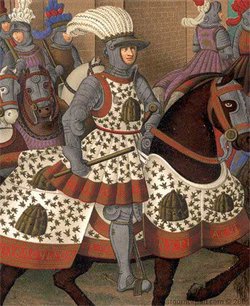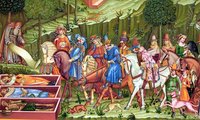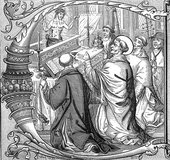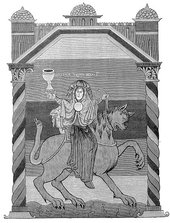Medieval History
|
|
The Middle Ages formed the middle period in a traditional schematic division of European history into three 'ages': the classical civilization of Antiquity, the Middle Ages, and modern times, beginning with the Renaissance. The Middle Ages of Western Europe are commonly dated from the end of the Western Roman Empire (5th century) until the rise of national monarchies, of European overseas exploration, the invention and diffusion of printing, and the humanist revival of the Renaissance in the 15th century in Italy, early 16th century in Northern Europe, as well as the Protestant Reformation starting in 1517. These various changes all mark the beginning of the Early Modern period that preceded the Industrial Revolution.
(The corresponding adjective, from the Latin medius aevus, is spelled medieval in American English and sometimes mediaeval or medi涡l in English in England.)
| Contents |
The Early Middle Ages
As the authority of the Roman Empire dwindled in Western Europe, its territories were entered and settled by succeeding waves of "barbarian" tribal confederations, some of whom distrusted and rejected the classical culture of Rome, while others, like the Goths admired it and considered themselves the legatees and heirs of Rome. Prominent among these peoples were non-Germanic Huns and Avars and Magyars with the large number of Germanic and later Slavic peoples. The era of the migrations has historically been termed the "Dark Ages" by Western European historians. That term has now fallen from favor, partly to avoid the entrenched stereotypes associated with the phrase, but also partly because more recent research into the period has in fact revealed its surprising artistic sophistication, though its political and social senses were unevolved and its technologies undeveloped, compared to the preceding culture.
Although the settled population of the Roman period were not everywhere decimated, the new peoples greatly altered established society, and with it, law, culture and religion, and patterns of property ownership. The Pax Romana, with its accompanying benefits of safe conditions for trade and manufacture, and a unified cultural and educational milieu of far-ranging connections, had already been in decline for some time as the 5th century drew to a close. Now it was largely lost, to be replaced by the rule of local potentates, and the gradual break-down of economic and social linkages and infrastructure. This break-down was often fast and dramatic as it became unsafe to travel or carry goods over any distance and there was a consequent collapse in trade and manufacture for export. Major industries that depended on trade, such as large-scale pottery manufacture, vanished almost overnight in places like Britain. The Islamic invasions of the 7th and 8th centuries, which conquered the Levant, North Africa, Spain and some of the Mediterranean islands (including Sicily), increased localization by halting much of what remained of seaborne commerce. So where sites like Tintagel in Cornwall had managed to obtain supplies of Mediterranean luxury goods well into the 6th century, this connection too was lost. Administrative, educational and military infrastructure quickly vanished, leading to the rise of illiteracy among leadership.
A new order
Until recently it has been common to speak of "barbarian invasions" sweeping in from beyond Imperial borders and bringing about the end of the Roman Empire. Modern historians now acknowledge that this presents an incomplete portrait of a complex time of migration. In some important cases, such as that of the Franks entering Gaul, settlement of the newcomers took place over many decades, as groups seeking new economic opportunities crossed into Roman territory, retaining their own tribal leadership, and acculturating to or displacing the Gallo-Roman society, often without widespread violence. Other outsiders, like Theodoric of the Ostrogoths, were civilized, though illiterate patrons, who saw themselves successors to the Roman tradition, employing cultured Roman ministers, like Cassiodorus. Like the Goths, many of the outsiders were foederati, military allies of the Empire, who had earned rights of settlement, including among others the Franks and the Burgundians. Between the 5th and 8th centuries a completely new political and social infrastructure developed across the lands of the former empire, based upon powerful regional noble families, and the newly established kingdoms of the Ostrogoths in Italy, Visigoths in Spain, Franks and Burgundians in Gaul and western Germany, and Saxons in England. These lands remained Christian, and their Arian conquerors were soon converted, following the example of the pagan Frank Clovis I. The interaction between the culture of the newcomers, the remnants of classical culture, and Christian influences, produced a new model for society. The centralised administrative systems of the Romans did not withstand the changes, and the institutional support for large scale chattel slavery largely disappeared.
However beyond these areas of Europe were many people with little or no contact with Christianity or with classic Roman culture. Warrior people such as the Avars and the Vikings were still capable of causing major disruption to the newly emerging societies of Western Europe. The Christian Church, the only centralised institution to survive the fall of the western Roman Empire intact, was the sole unifying cultural influence, preserving its selection from Latin learning, maintaining the art of writing, and a centralised administration through its network of bishops. The Early Middle Ages are characterized by the urban control of bishops and the territorial control exercised by dukes and counts. The rise of urban communes marked the beginning of the High Middle Ages.
Outside the de-urbanized remains of cities, the power of central government was greatly reduced. Consequently government authority, and responsibility for military organisation, taxation and law and order, was delegated to provincial and local lords, who supported themselves directly from the proceeds of the territories over which they held military, political and judicial power. In this lay the beginnings of the feudal system. The High Middle Ages would see the regrowth of centralized power, and the growth of new "national" identities, as strong rulers sought to eliminate competition (and potential threat to their rule) from powerful feudal nobles. Well known examples of such consolidation include the Albigensian Crusade and the Wars of the Roses.
This hierarchy of reciprocal obligations, known as feudalism or the feudal system, binding each man to serve his superior in return for the latter's protection, made for a confusion of territorial sovereignty (since allegiances were subject to change over time, and were sometimes mutually contradictory). The benefit of feudalism however, was its resiliency, and the ability of local arrangements to provide stable government in the absence of a strong royal power in a political order distinguished by its lack of uniformity. Territoriality was reduced to a network of personal allegiances.
In the east, the Eastern Roman Empire (called by historians the "Byzantine Empire"), maintained a form of Christianised Roman rule in the lands of Asia Minor, Greece and the Slavic territories bordering Greece, and in Sicily and southern Italy. The eastern emperors had maintained a nominal claim to rule over the west, reconquered by Belisarius, but this was a political fiction under Lombard rule and became strongly disputed from 800, with the creation of the so-called Holy Roman Empire, under Charlemagne, briefly uniting much of modern day France, western Germany and northern Italy. From now on, Europe was to be bi-polar, with east and west competing for power and influence in the largely un-christianised expanses of northern Europe.
The spread of Christianity in the Migrations Period, both from the Mediterranean area and from Ireland, occasioned a pre-eminent cultural and ideological role for its abbots, and the collapse of a res publica meant that the bishops became identified with the remains of urban government. Christianity provided the basis for a first European "identity," Christendom, unified until the separation of Orthodox Churches from the Catholic Church in the Great Schism of 1054, one of the dates that marks the onset of the High Middle Ages.
A limited Carolingian Renaissance
- See the careers of Charlemagne and Otto I, Holy Roman Emperor.
The High Middle Ages
Main article: High Middle Ages
From roughly the year 1000 onward, greater stability came to the lands of western Europe. With the brief exception of the Mongol incursions, major barbarian invasions had ceased. The advance of Christian kingdoms and military orders into previously pagan regions in the Baltic and Finnic northeast brought the forced assimilation of numerous native peoples to the European entity.
In central and northern Italy and in Flanders the rise of towns that were self-governing to some degree within their territories marked a beginning for re-urbanization in Western Europe.
In Spain, a slow reconquest of the urban and literate Muslim-ruled territories began. One consequence of this was that the Latin-literate world gained access to libraries that included classical literature and philosophy. Through translations these libraries gave rise to a vogue for the philosophy of Aristotle. Meanwhile, trade grew throughout Europe as the dangers of travel were reduced, and steady economic growth resumed. This period saw the formation of the Hanseatic league and other trading and banking institutions that operated across western Europe. The first universities were established in major European cities from 1080 onwards, largely to train the clergy. Literacy began to grow, and there were major advances in art, sculpture, music and architecture. Large cathedrals were built across Europe, first in the romanesque, and later in the more decorative gothic style.
The Crusades
Main article: Crusade
Following the Great Schism, prime examples of the force of the divided cultural identities of Christendom can be found in the unfolding developments of the Crusades, during which Popes, kings, and emperors drew on the concept of Christian unity to inspire the population of Western Europe to unite and defend Christendom from the aggression of Islam, often at the expense of the Byzantine Empire. From the 7th century onward, Islam had been gaining ground along Europe's southern and eastern borders. Muslim armies conquered Egypt, the rest of North Africa, Jerusalem, Spain, Sicily, and most of Anatolia (in modern Turkey), although they were finally turned back in western Europe by Christian armies at the Battle of Tours in southern France. Political unanimity in Europe was less secure than it appeared, however, and the military support for most crusades was drawn from limited regions of Europe. Substantial areas of northern Europe also remained outside Christendom until the twelfth century or later; these areas also became crusading venues during the expansionist High Middle Ages.
Technology
Main article: Medieval technology
During the 12th and 13th century in Europe there was a radical change in the rate of new inventions, innovations in the ways of managing traditional means of production, and economic growth. In less than a century there were more inventions developed and applied usefully than in the previous thousand years of human history all over the globe. The period saw major technological advances, including the invention of printing, gunpowder, the astrolabe, spectacles, and greatly improved ships. They also improved upon the clock. The latter advances made possible the dawn of the Age of Exploration.
Alfred Crosby described some of this technological revolution in The Measure of Reality : Quantification in Western Europe, 1250-1600 and other major historians of Technology have also noted it.
The Late Middle Ages
The 14th century witnessed a decline that began with the first economic retrenchment after the long, gently inflationary rise of a unified economy that had been under way since the 11th century. The European climate itself was worsening, after the long Medieval Warm Period, leading to the onset of the Little Ice Age. In the Black Death, large areas of Western Europe lost up to a third of their population, especially in the crowded conditions of the towns, where the heart of innovations lay. The Black Death sealed a sudden end to the previous period of massive change, which resumed centuries later in the Early Modern Period.
Politically, the later Middle Ages were typified by the decline of feudal power, slowly increasing disorder, and the development of strong, royalty-based nation-states, partly as an outcome of these two trends. Wars between kingdoms, such as the Hundred Years' War between England and France, weakened the Christian nations in their confrontations with Islam. The Great Famine of 1315-1317, the Black Death of 1348, The schism of the Christian church, popular uprisings, were all disastrous for the old medieval order, laying the groundwork for further great changes in the 15th and 16th centuries.
In the east, the Byzantine Empire followed a separate destiny, with its strongest period coinciding with the Western collapse during the Early Medieval period. After the Battle of Manzikert (1071), the former empire was reduced to a shell; it survived until 1453, but in a diminished and weakened form.
Historiography
Middle Ages in history
See main article: Middle Ages in history
After the Middle Ages ended with the Renaissance, subsequent generations imagined, portrayed and interpreted the Middle Ages in different ways. Every century has created its own vision of the Middle Ages, the 18th century view of the Middle Ages was entirely different from the 19th century which was different from the 16th century view. The reality of these images remains with us today in the form of film, architecture, literature, art and popular conception.
Origin and use of term
The term "Middle Ages" was invented by Italian humanists in the early 15th Century. Until the Renaissance (and some time after) the standard scheme of history was to divide history into six ages, inspired by the biblical six days of creation, or four monarchies based on Daniel 2:40. The early Renaissance historians instead talked about two periods in history, that of Ancient times and that of the period referred to as the "Dark Age." In the early 15th Century it was believed history had evolved from the Dark Age to a Modern period and scholars began to write about a middle period between the Ancient and Modern, which became known as the Middle Ages. This is known as the three period view of history.
The plural form of the term, Middle Ages, is used in English, Dutch, Russian and Icelandic while all other European languages uses the singular form. This difference originates in different Neo-Latin terms used for the Middle Ages before media aetas became the standard term. Some were singular (media aetas, media antiquitas, medium saeculum and media tempestas), others plural (media saecula and media tempora). There seem to be no simple reason why a particular language ended up with the singular or the plural form. Further information can be found in Fred C. Robinson: "Medieval, the Middle Ages" in Speculum, Vol. 59:4 (Oct. 1984), p. 745-56.
The common subdivision Early, High and Late Middle Ages came into use after World War I. It was caused by the works of Henri Pirenne (in particular the article "Les periodes de l'historie du capitalism" in Academie Royale de Belgique. Bulletin de la Classe des Lettres, 1914) and Johan Huizinga (The Autumn of the Middle Ages, 1919).
A medieval era can also be applied to other parts of the world that historians have seen as embodying the same feudal characteristics as Europe in this period. The pre-westernization period in the history of Japan is sometimes referred to as medieval. The pre-colonial period in the developed parts of sub-Saharan Africa is also sometimes termed medieval. Today historians are far more reluctant to try to fit the history of other regions to the European model and these terms are less often used.
Periodization issues
See also Periodization
It is extremely difficult to decide when the Middle Ages ended, and in fact scholars assign different starting dates for the Renaissance in different parts of Europe. Most scholars who work in 15th century Italian history, for instance, consider themselves Renaissance or Early Modern historians, while anyone working on England in the early 15th century is considered a medievalist. Others choose specific events, such as the Turkish capture of Constantinople or the end of the Anglo-French Hundred Years' War (both 1453), the invention of printing by Johann Gutenberg (around 1455) or the fall of Muslim Spain or Columbus's voyage to America (both 1492), or the Protestant Reformation starting 1517 to mark the period's end. In England the change of monarchs which occurred on 22 August 1485 at the Battle of Bosworth is often considered to mark the end of the period, Richard III representing the old medieval world and the Tudors, a new royal house and a new historical period.
Similar differences are now emerging in connection with the start of the period. Traditionally, the Middle Ages is said to begin when the West Roman Empire formally ceased to exist in 476 CE. However, that date is not important in itself, since the West Roman Empire had been very weak for some time, while Roman culture was to survive at least in Italy for yet a few decades or more. Today, some date the beginning of the Middle Ages to the division and Christianization of the Roman Empire (4th century) while others, like Henri Pirenne see the period to the rise of Islam (7th century) as "late Classical".
The Middle Ages are often subdivided into an early period (sometimes called the "Dark Ages", at least from the fifth to eighth centuries) of shifting polities, a relatively low level of economic activity and successful incursions by non-Christian peoples (Slavs, Arabs, Scandinavians, Magyars); a middle period (the High Middle Ages) of developed institutions of lordship and vassalage, castle-building and mounted warfare, and reviving urban and commercial life; and a later period of growing royal power, the rise of commercial interests and weakening customary ties of dependence, especially after the 14th-century plague.
Religion in the Middle Ages
- Holy Roman Empire
- The Crusades
- Pilgrimage
- Papacy
- Medieval Inquisition
- Heresy (for example, Arian; Cathar; John Wyclif)
- Alchemy
- Monastic orders
- Mendicant friars
- Judaism
- Islam (Western Europe): Moors
- Islam (Eastern Europe): Sultanate of Rum & Ottoman Empire
See also
- Medieval art
- Medieval architecture
- Medieval climate optimum
- Medieval communes
- Medieval demography
- Middle Ages in film
- Medieval guilds
- Medieval hunting
- Medieval medicine
- Medieval music
- Medieval tournament
- Slave trade in the Middle Ages
- History of the Jews in the Middle Ages
Selected bibliography
- Monumenta Germaniae Historica
- Migne's Patrologiae
- Liber Pontificalis
- C. Warren Hollister and Judith M. Bennett, Medieval Europe, A Short History. McGraw-Hill, 2002.
- David Abulafia et al., The New Cambridge Medieval History. Cambridge, 1995.
External links
- Internet Medieval Sourcebook Project (http://www.fordham.edu/halsall/) Primary source archive of the Middle Ages. See also Internet Medieval Sourcebook.
- The Online Reference Book of Medieval Studies (http://www.the-orb.net/) Academic peer reviewed articles. See also Online Reference Book of Medieval Studies.
- The Labyrinth (http://labyrinth.georgetown.edu/) Resources for Medieval Studies.
- NetSERF (http://www.netserf.org/) The Internet Connection for Medieval Resources.
- Interactive Medieval Map (http://www.medievalmap.net) (Flash Plug-in Required.)
- Cunnan: A Wiki collecting information for re-enactors of the Middle Ages and Renaissance (http://www.sca.org.au/cunnan/) with a heavy slant towards members of the SCA
- Shadowed Realm - Your Guide to Medieval History (http://www.shadowedrealm.com/) Contains over 600 glossary terms, a timeline, quotatations, quizzes, external links, and more.
- Contains Medieval Castles and their history. (http://www.medieval-castles.org)





